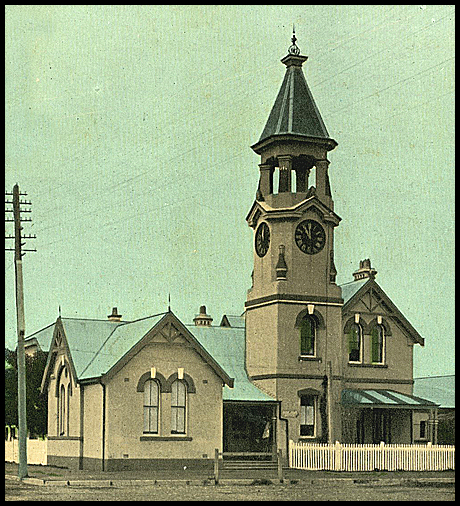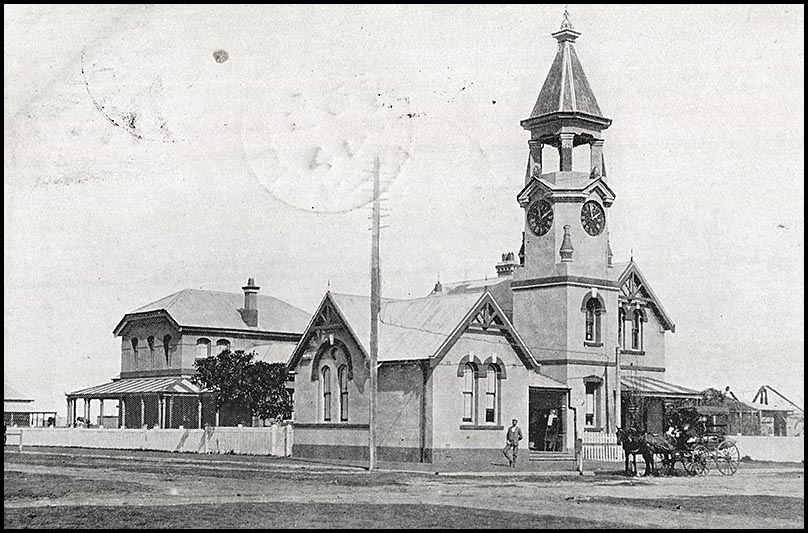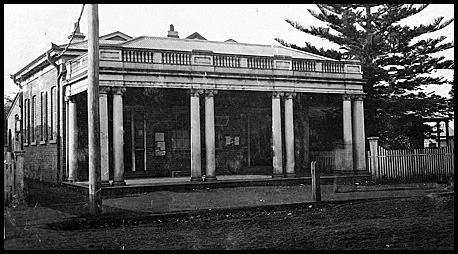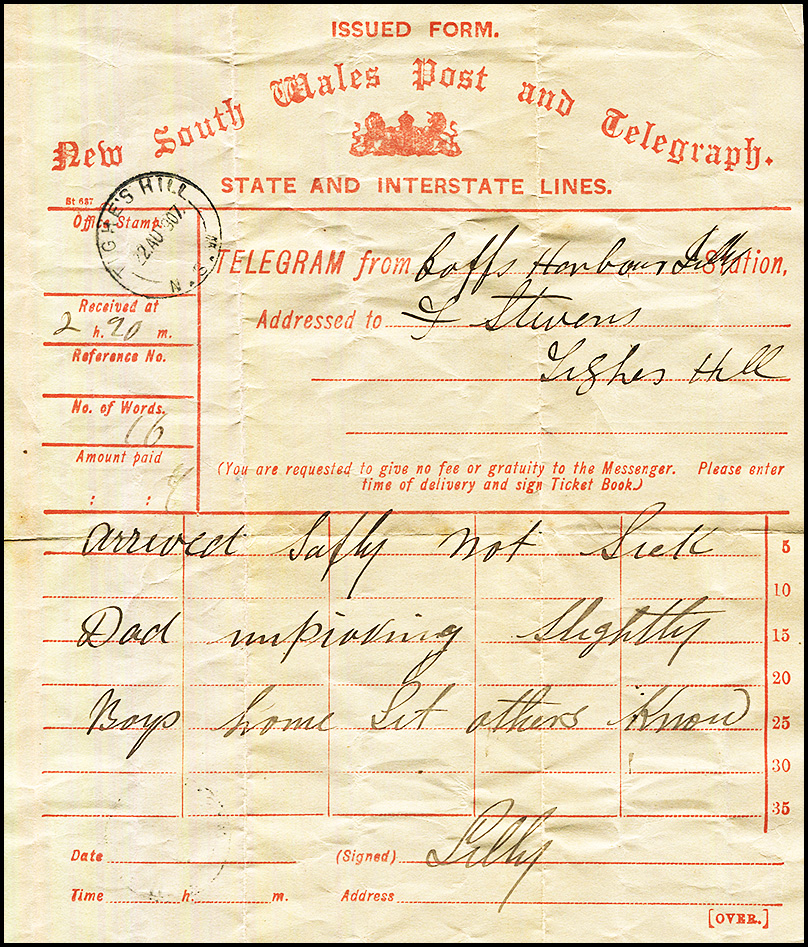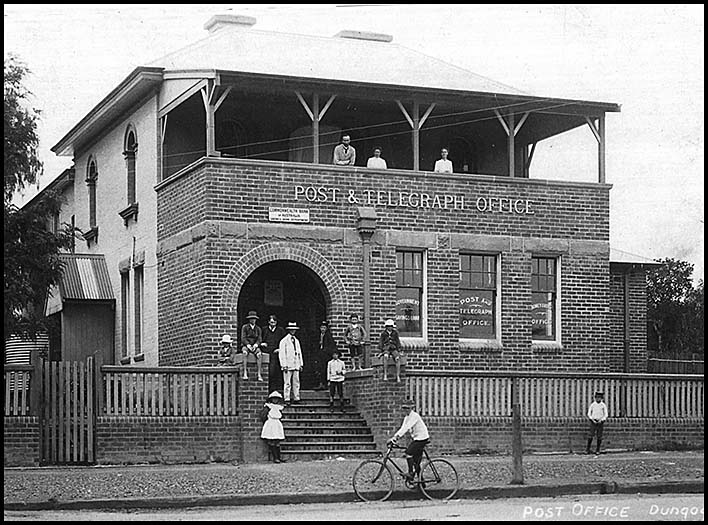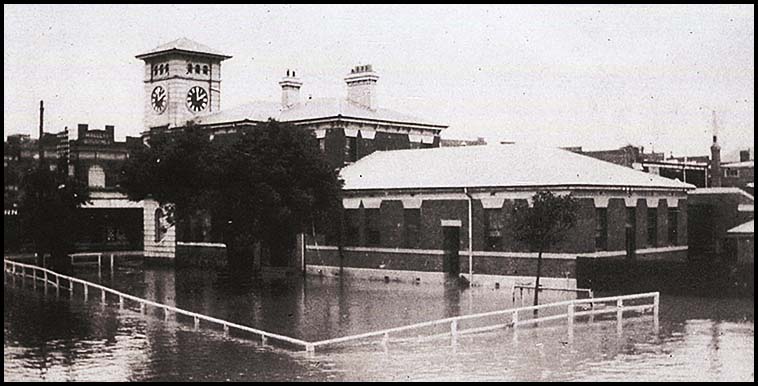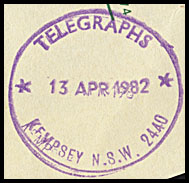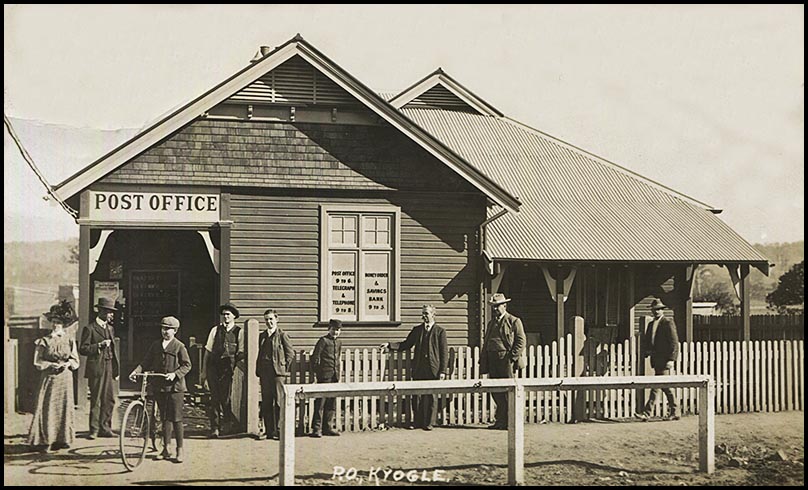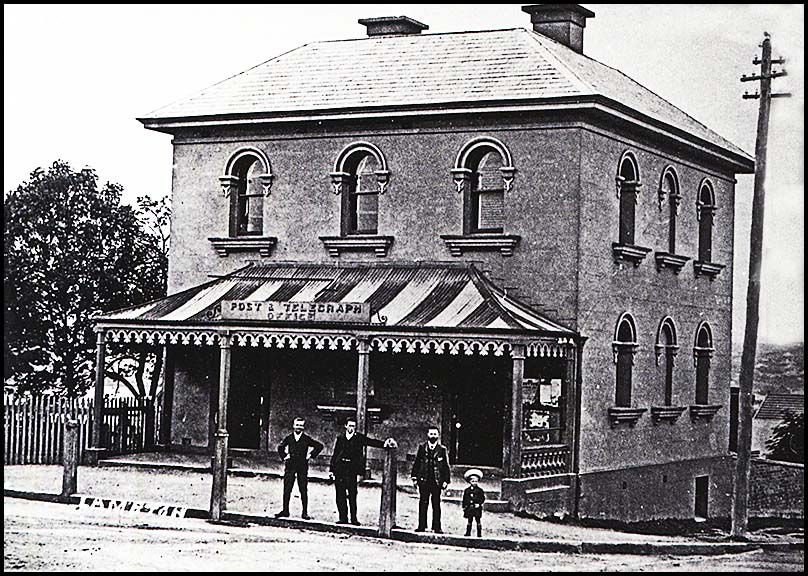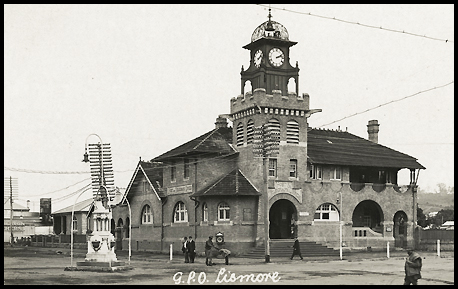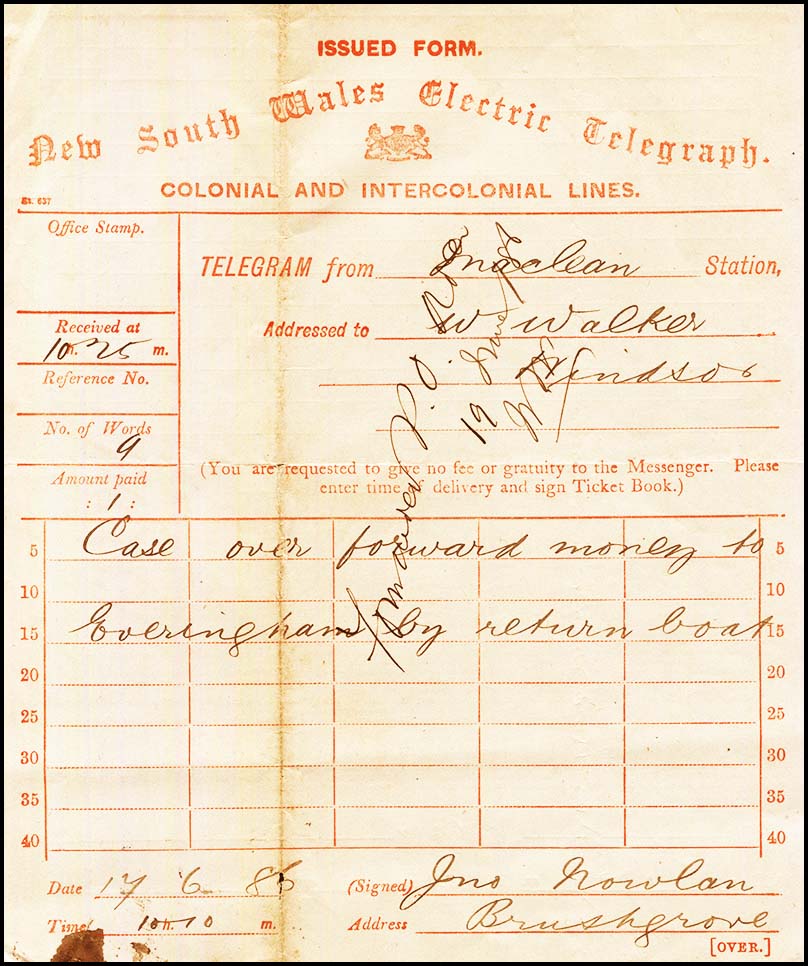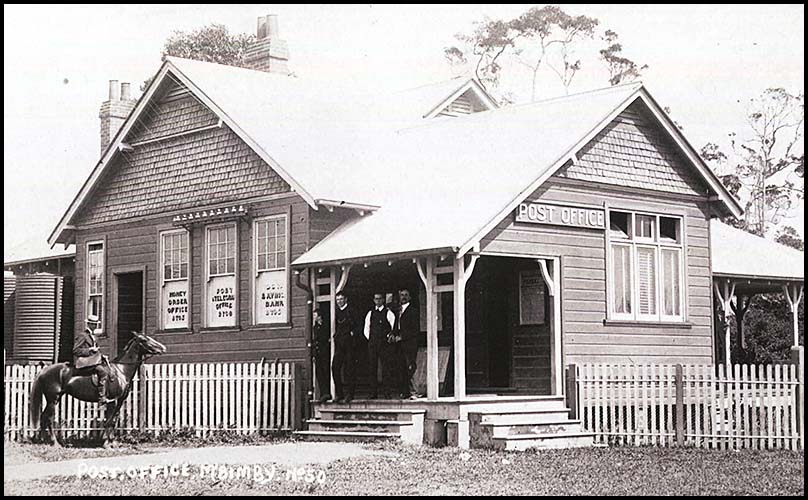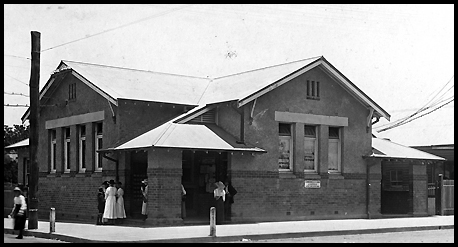Telegraph Offices in the North East region.
- Australia 1901-1988
- New South Wales
- Queensland
- South Australia
- Tasmania
- Victoria
- Western Australia
- International
- Special aspects
The following Telegraph Offices are included on this page:
|
The Post and Telegraph Office was opened on 2 April 1883. The Post Office had opened on 15 May 1871 with Mr. J. R. Redstone as Postmaster. Personnel: May 1883: Miss Emily Redstone was appointed the first Station Mistress. |
|
The Telegraph Office opened on 21 March 1877. Mr. Blackwell was appointed as Station Master. A Post Office was established on 1 April 1879 at BOOLAMBAYTE, between BULAHDELAH and BUNGWALL FLAT. |
|
A Telegraph Office was opened on 7 August 1888. |
| Coffs Harbour.
The Telegraph Office was opened as a P&T Office on 24 August 1891. The Post Office had opened on 1 August 1890. |
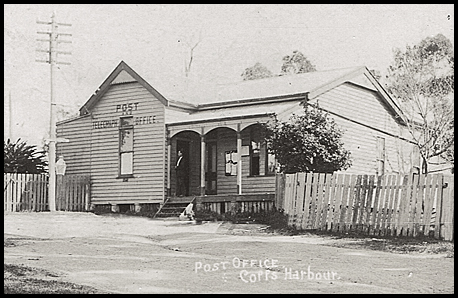 Post and Telegraph Office at Coffs Harbour. |
Early usage: The earliest evidence of the operation of the Telegraph Office at Coffs Harbour is a delivery form (NI-DO-1) used for a message to Tighe's Hill on 22 August 1907 - 27 years and three weeks after opening. |
|
Date stamps: No special date stamp for use with telegrams was issued to Coffs Harbour. |
|
|
A Post Office had opened on 1 January 1835. The Telegraph Office opened on 7 July 1874 (in provisional premises) and the two offices were combined on 15 September 1875. In the Legislative Assembly of 1 November 1878, Mr. Burms, in reply to Mr. Johnston, said tenders for a Post and Telegraph Office at Dungog would be invited in about a month's time. Much later, residents of Dungog had the most unusual idea that they would like to be connected with Maitland by telephone. On 12 September 1903, the residents received a reply to their request with the charges laid out. Clearly the costs and the ways to calculate were a trial run for the NBN some years laer. |
|
Personnel: July 1874: Mr. Thomas H. Ryan who had formerly been an Operator at the Newcastle Telegraph Office was appointed as the first Station Master. June 1875: Mr. John Sheridan was appointed as Line Repairer. July 1876: Mr. Thomas H. Ryan Telegraph Master at Dungog exchanged positions with Mr. Charles of Fry, Telegraph Master at Coonamble. |
|
The Telegraph connection was made with Emmavile about 20 September 1882. Tenders were advertised in April-May 1883 for the construction of a Post and Telegraph Office at Emmaville. |
|
The telegraph line to Forster was completed in March 1882. But - on 14 April 1882, the Manning and Hastings Advocate noted the following: "Although the telegraph line to Forster has been completed, no operator has as yet put in an appearance; and no doubt the station will remain without one until such time as those in charge of the Circumlocution Office are again aroused from their lethargy. It is the old story, no public work is considered complete unless there is a pile of official correspondence attached to it. In these enlightened times, the promoter of a public scheme finds it necessary to provide himself with at least a ream of foolscap, and a corresponding quantity of official envelopes, before he is fully equipped for the work on hand; and he may consider himself fortunate if his efforts be successful by the time he arrives at the last sheet. This must account for the enormous quantity of red tape annually used in the various departments. It is "an official hobby" — business would be at a standstill without it" (see also the story of the coloured telegraph posts). A Telegraph Office opened at Forster on 1 May 1882. and combined with the Post Office on 1 June (one month later). |
|
A Telegraph Office was opened on 3 October 1877. It combined with the Post Office (which had been opened on 1 June 1859) on 20 July 1878.
|
| Grafton (Clarence River).
The Telegraph Office opened on 17 December 1862 with Messrs. Nunn and Smithers in charge. The Post Office had opened as Clarence River on 1 October 1849 and changed name about 1849. The Telegraph Office merged with the Post Office on 1 January 1870. The Sydney Morning Herald of 19 November 1868 reported on a meeting in the School of Arts. In part "it was not deemed necessary that provision should be made for the erection of a (Post Office) building, as it is considered that sufficient accommodation could be provided by making such additions to the Electric Telegraph Office as would render that office suitable for the double purpose of Post and Telegraph office. With reference to the appointment of an Official Postmaster, it has of late been found expedient, on the grounds of economy, and also on the ground that the plan is one which offers all the advantages of an official Post Office, to amalgamate the duties of Postmaster and Telegraph Station master". |
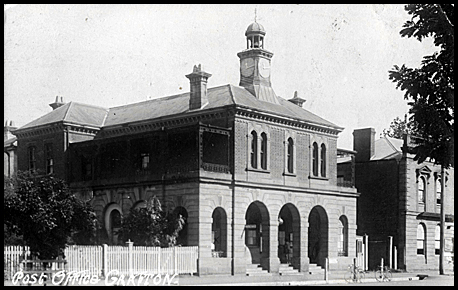 The 1875 Grafton Post & Telegraph Office. |
|
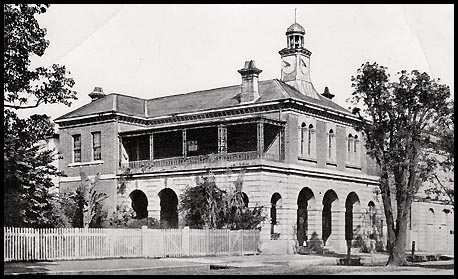 |
||
All of the following history would have been written very differently had the movement to separate Grafton from New South Wales (as they saw it Sydney) and either form a new Colony or possibly link with Queensland been seen through to fruition. See 1860 taxes, 1860 Improvement Association and the Separation Movement. In "The Blue Book" for 1870, the Grafton Post & Telegraph Office is recorded as:
"And yet the whole of this business, most of which is of the greatest importance to the general public, is obliged to be carried on in a room scarcely twelve feet square. In this miserable room, the employees of the establishment have to perform all the operations of the telegraph, and attend to all and several of the other duties of the establishment. The access to this wonderful place is by a small lobby of about four feet square, surrounded by a partition covered with green baize, by means of a small hole in the partition of about six inches square; within this little lobby visitors, are supposed to write their telegrams, purchasers secure their stamps, depositors pay their money and all enquiries about Post-Office matters are supposed to be made. Under such circumstances, secrecy is impossible. If an attempt be made to write a telegraphic slip, you are hindered by a host of enquirers and waiters upon other matters; the only alternative for a quiet citizen is to wait out in the street, till fortune smiles upon him and gives him an opportunity of access into the public hall of this magnificent establishment. If even a verandah was erected in the front, waiters would be in the dry and out of the heat and dust, but alas that is a luxury - which is too far in the distance for Grafton. We have become so accustomed to the thing that perhaps, any alteration would be regarded an innovation, and would be looked upon as a reckless expenditure in these days of retrenchment. But why should such a state of things remain - public convenience should not be ignored altogether. Other places in the colony have respectable Post and Telegraph Offices. Why should Grafton and the Clarence be the exception? This matter has again and again been brought under the notice of the Government - promises have been made and reiterated, but still the same neglect". (The Clarence and Richmond Examiner 16 April 1872, p. 2). Tenders for the "Erection of a Telegraph Station at Grafton" closed on 23 September 1873. In October the construction for the erection was awarded to Mr. William Kinnear. The laying of the Foundation Stone for the new building in Victoria Street took place on 8 October 1874: "The foundation stone of the Post and Telegraph offices, Grafton, was laid by Mrs. Fisher, the wife of the Mayor of Grafton. She was presented with a handsome trowel and a mallet. An address was read by her, and Mr. Bawden M.L.A., made a speech pertinent to the occasion. The children of the public school were present, among the large gathering of people to witness the ceremony, and they sang the National Anthem. They were afterwards regaled with cakes, etc. A public luncheon in the School of Arts followed with the Mayor in the chair". Personnel: January 1863: Mr. Walter J. Nunn was appointed Station Master. January 1863: Mr. Henry H. Smithers was appointed Line Inspector. April 1873: Mr. Thomas Quirk was appointed as Telegraph Station Master. About 1883: "During a thunderstorm yesterday afternoon (23 Jan 1883) a flash of lightning entered the South Grafton telegraph office, rendering Mrs. Phillips, wife of the Post and Telegraph Master, insensible for upwards of an hour. It appears she was in the room at the back of the office through which the wires are conducted. The gutta percha covering of the wire was all fused and other trifling damage done, cutting off communication temporarily. Other than the shock to the nervous system, Mrs. Phillips is not seriously hurt". In the 1890s, Mr. R. C. Williams was in charge. The memoirs of Mr. W. Orr from his appointment as a Telegraph Messenger at Grafton to his retirement were published in the Northern Star of 25 June 1934. |
||
A steel circular Type 2C TELEGRAPHS GRAFTON date stamp was used at Grafton:
|
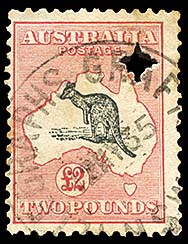 12 May 1935. Small Multiple watermark. |
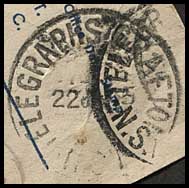 22 January 1945. Used on AW-DO-9E. |
| Greta.
On 30 June 1875, the Miners Advocate reported that "Our Anvil Creek and Greta friends will be pleased to learn that tenders are being called for the erection of a Post and Telegraph Office at Anvil Creek. This will indeed prove a boon for such offices are badly wanted". A Post & Telegraph Office was opened in Greta on 1 October 1886. On 30 May 1906, the Telegraph Office was reclassified as a Telephone Service but it continued to handle all telegraphic matters. A Telegraph Office was opened at the Railway Station on 14 September 1894 but it had closed by 1902. Greta had a coal mine which produced low grade coal. When prices fell in the early 1890s, the mine became unprofitable and it closed in 1894. |
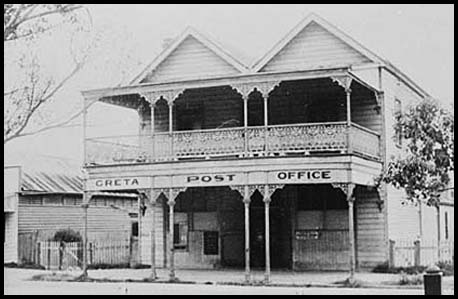 Greta Post Office April 1893 - no reference to the Telegraph. Greta Post Office April 1893 - no reference to the Telegraph.The image was scanned from the original glass negative taken by Ralph Snowball. Reproduced with acknowledgment of the Norm Barney Photographic Collection in the Cultural Collections at the University of Newcastle. Source: livinghistories.newcastle.edu.au/nodes/view/43201 |
In May 1902, the Government Architect received instructions from the Postmaster-General to carry out alterations to the Post & Telegraph Office. On 8 April 1904, the Newcastle Herald reported that new telegraph poles had arrived to enable the local Post & Telegraph office to be connected to the main line. On 30 May 1906, the Newcastle Herald reported: "The telephone at the post-office, having been connected with Branxton, the telegraph instruments, etc., have been dispensed with and were taken away on Tuesday afternoon. Consequently all telegrams to and from Greta will have to be repeated at Branxton. Mr. Edmondson, from Maitland post office, who has been relieving here for several weeks owing to the illness of Mr. Jackson, Postmaster, will now return to Maitland leaving the post-office in charge of Mrs. and Miss Jackson until Mr. Jackson, son of the former, recovers and is able to take charge. Arrangements have been made so that messages sent and received will be private". In 1913, the Post & Telegraph Mistress - Miss F Quinn - was replaced by Mr. H. J. Nowland. Miss Quinn and her two sisters - who had acted as assistants for the previous three years, were returning to Sydney. Mr. Nowland announced he was expecting an additional telephone bureau and new telegraph equipment to be arriving shortly. |
|
| The letter on the back of the postcard at the right is dated 19th Nov (19)16 and it states: Dear Stan I suppose you recognise this office in which you reigned as P.M. for a time. The photographer was ashamed to put his name on it. I suppose you will recognise Mum. Jenton is the messenger. My sister & I on the balcony. She is the worst looking one. Harold was nowhere to be found. We have let the attics to the Starling family. By the sound up there I think there are several generations. The trouble is the rent question. We've been here 3 months now and not a penny have we got. |
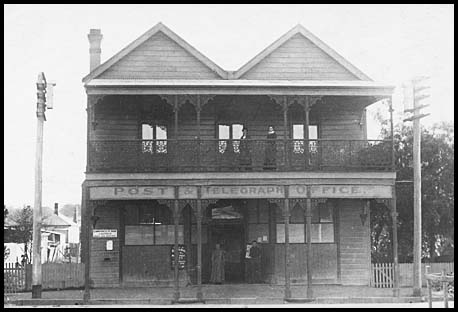 The Greta Post & Telegraph Office about 1905. |
| Kempsey (Macleay River).
The Telegraph Office opened (in Central Kempsey) in 1878 and merged with the Post Office on 1 July 1880. The Post Office had opened on 1 September 1843. |
||
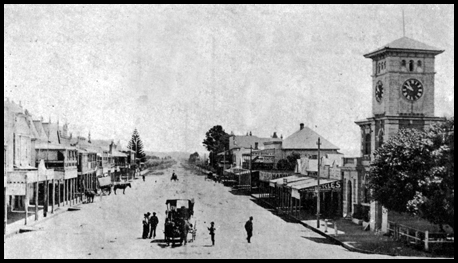 An earlier picture of the Post Office based on a comparison with the fewer and simpler telegraph poles outside compared to the picture at the right. In addition, the clock says its 30 minutes earlier :-). |
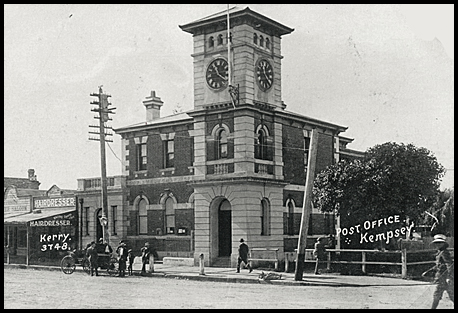 |
|
|
||
| Three types of date stamp were issued to Kempsey for use with the telegraphs: | ||
|
|
|
|
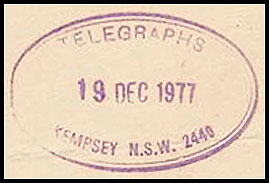 19 December 1977. Used on AT-TO-15A. |
|
|
Used on AT-DO-14B. |
|
| A Telegraph Office also opened at the Railway Station on 28 April 1924 although no special date stamp is recorded. It closed on 30 June 1962. | ||
|
A Telegraph Office was opened on 22 August 1905. |
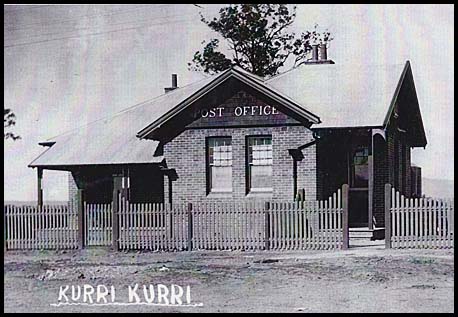 |
|
|
The Post and Telegraph Office was opened on 27 January 1903. |
|
|
On 7 October 1874, the Miner's Advocate informed its readers that the tender submitted by Mr. Kinshela had been accepted "for the extension of the telegraph line from Newcastle to Lambton". By 3 April 1875, "Mr. Maddock is pushing on the new Telegraph Office in right good style, and soon we expect to see the wires being taken into the office ; the building is next to Mr. Maddock's shop, and is being substantially built of brick" (Newcastle Chronicle). The Telegraph Office opened on 29 May 1875 at the corner of Morehead and Dickson Streets. |
|
| A Post Office was opened at Lambton on 1 March 1865. The two offices merged in to Post & Telegraph Office on 19 November 1878.
An excellent review of the Post and Telegraph Office is that by Lachlan Wetherall. Personnel: April 1880: Mr. Hiram J. Rowthorn, a probationer in the Telegraph Office, was transferred to Lambton to be Station Master in lieu of Mr. Harris. |
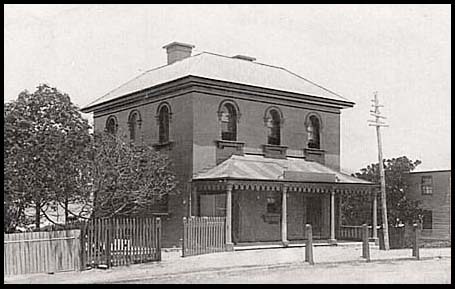 |
|
|
| Lismore.
The Telegraph Office opened on 1 December 1875 and merged with the Post Office on 1 March 1875. The Post Office had opened on 1 October 1859. In 1897, a tender of £ 3,340 was accepted to erect a new building designed by the Government Architect W. Vernon in the Federation style. It was opened on 1 December 1898. |
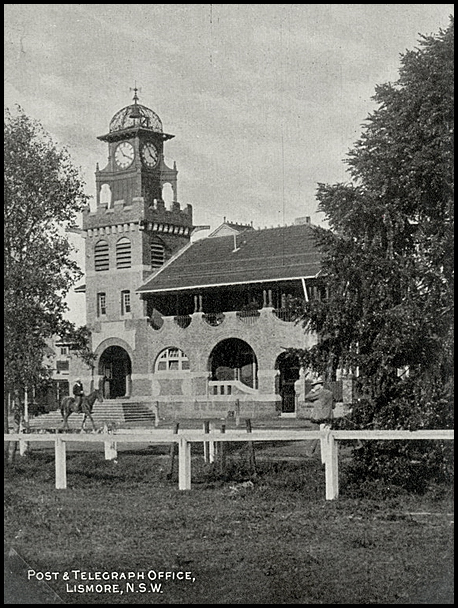 |
The photographs below show little change to the P&T building (except to the front steps) but lots of changes to nearby structures. |
|
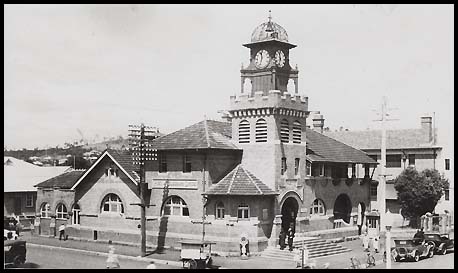 |
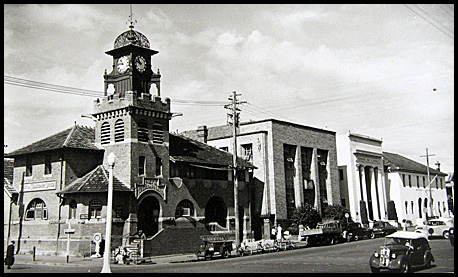 |
Throughout the Colony, a number of Telegraph Offices (e.g Bathurst) installed a device so that Sydney Telegraph Message could transmit a signal which would drop a ball to indicate an agreed time - such as 1:00 pm. Then all inhabitants and merchants had a fixed time to work from. The Grafton Argus of 8 March 1875 commented on an alternative approach: "The inhabitants of this township (Lismore) have purchased a small cannon to denote the Sydney time daily at one o'clock. I trust it will not meet with the same fate as the Grafton one, nor will our telegraph master be drawn into a lawsuit on its account. But if such an unpleasant circumstance did happen, we would be equal to the occasion, and follow in the footsteps of the Graftonians, by defraying all expenses. I don't think we shall have cause to regret having purchased the gun. The residents will now be enabled to keep uniform time. I do not think there is any one in our little township so contemptible as to stoop to such an action as spiking a gun, thereby depriving his neighbours and the poor people from ascertaining the correct time, if unable to buy a clock". The Sydney Mail of 10 May 1879 reported that "A movement is on foot to send a deputation to Sydney to urge on the Government to take immediate action in the matter of the great inconvenience experienced here, in consequence of the Lismore Post and Telegraph Master having no assistance, though there is a large amount of business transacted". Personnel: September 1875: "A complimentary dinner has been given at Lismore to Mr. Ralph Richardson for the manner in which he has carried out the telegraphic works in the neighbourhood" (Sydney Morning Herald 13 September 1875). July 1877: Mr. George Williams, a probabationer at Wsst Kempsey was appointed Line Repairer. |
|
A TELEGRAPHS LISMORE date stamp is recorded.
|
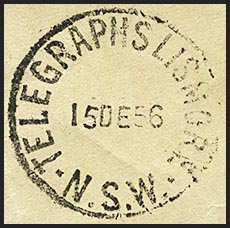 15 December 1956. Used on AA - DO- 13A. |
| No other special date stamp was issued to the Lismore Telegraph Office for use with telegraphic matters. The usual postal date stamp was used on telegram forms and (sometimes) on delivery envelopes.
|
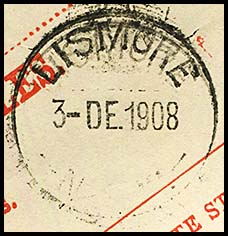 3 December 1908. Used on NSW delivery form NI-DO-4C with delivery envelope shown as NC-EO-5E. |
| The only TELEGRAM slogan cancellation recorded as having been used at Lismore is SEND A TELEGRAM.
Only two recorded examples of its use: on 25 September 1937 and 22 January 1941. |
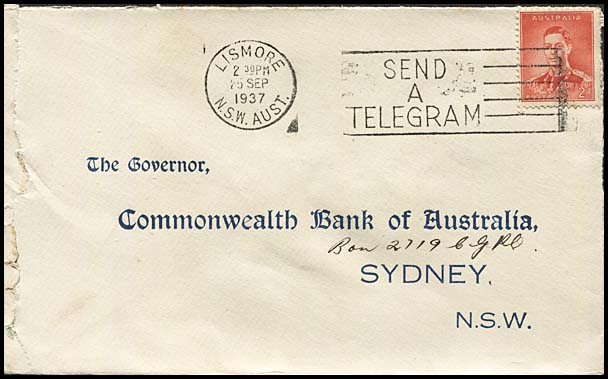 |
|
The Post and Telegraph Office opened at Maclean on 1 April 1885. On that date, there was a change of name from Rocky Mouth. |
(Very) Early usage. The first evidence now available of the operation of the Maclean Telegraph Office is a delivery form (NC-DO-8A) sent from Maclean to Windsor dated 17 June 1886 - just 14½ months after the Office opened. |
|
|
The Post and Telegraph Office was opened on 1 May 1898. |
|
|
A Telegraph Office was opened on 27 February 1877. It combined with the Post Office (which had been opened on 1 April 1851) on 20 April 1878. |
|
A Telegraph Office was opened at Uralla on 1 December 1867. The Post Office had opened on 1 February 1858. The two offices combined on 1 August 1870. It does not appear that Uralla had a special date stamp issued to it for use with telegraphic work. |
|
|
Expenditure of £1,575 for an extension of the line to Walcha had been approved by the Assembly in March 1869. A Telegraph Office is reported by Hopson and Tobin as opening on 11 January 1877 but that seems to be very late. Perhaps it was the opening of a new building. Even later - in the Estimates tabled by Public Works on 12 February 1881, £1,000 was included to construct a Post and Telegraph Office at Walcha. In January 1883, the tender submitted by Seabrook and Brown for the construction of a Post and Telegraph Office was accepted. |
|
On 26 February 1875, telegraphic communication was opened to Wallsend. Later that year, the Miners' Advocate of 27 November 1875 reported as follows: "The work of this office is steadily increasing, but as yet the operator Mr. Chapman has not got a messenger. Wallsend is a large and scattered township and the work of delivering the messages is no easy task considering the large number that pass throught the office daily. We hope the Postmaster-General will do something in connection with this office before long. The operator is insufficiently and shamefully paid and a more energetic and obliging servant is not to be found in the department. Also the crib where business is conducted might easily be renovated and then not deteriorate in public estimation". Personnel: October 1876: Mr. Oliver Haydock was appointed Postmaster and Electric Telegraph Master at Wallsend. |
|
A Post & Telegraph Office was established on 22 December 1891. A Post Office had been created when Wyong Railway Station was renamed on 1 April 1889. The Railway office never had telegraph facilities. |
|
A rubber circular TELEGRAMS date stamp (RO1 - T) was issued to the Office for use with telegraphic business. It is the only NSW date stamp inscribed TELEGRAMS.
|
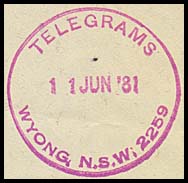 |
|
Established as Clarence River Heads. A Post Office was opened on 3 October 1862. The Telegraph Office opened in 1877. The two branches amalgamated on 1 July 1877. The name of the Office was changed to Yamba on 1 June 1885. On 7 March 1874, the Maitland Mercury reported "A female has been appointed to the charge of the Clarence Heads Telegraph Office". One may ask "for the female's name". Alas, the article did not provide that information. It did however provide the names of the winners of each of the Melbourne horse races. The Gazette of 13 March 1874 did name the appointee as Miss. E. H. Williams - appointed to be Telegraph Operator to replace Mr. Mr. Freeburn. On 10 October 1874, the Singleton Argus reported: "on the 26th ultimo, Miss E. H. Williams, telegraph operator at the Clarence Heads, was presented with a gold watch and chain by Mr. S. B. Eadon, M.D., on behalf of her friends on the Clarence and Richmond as a mark of their esteem for the very able and satisfactory manner in which she has discharged the functions of her office since her appointment".
|
